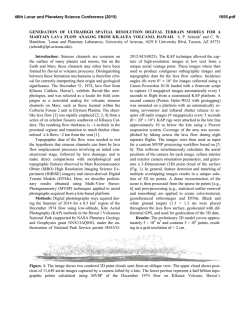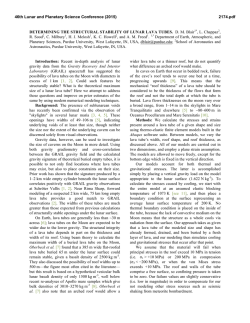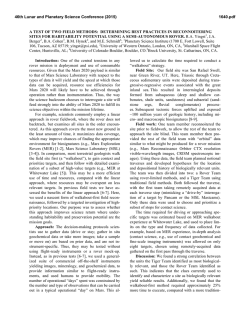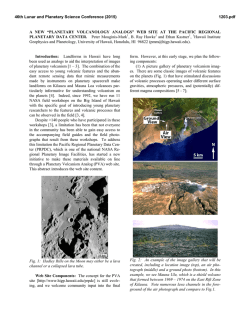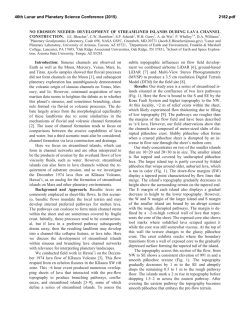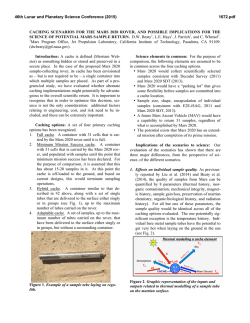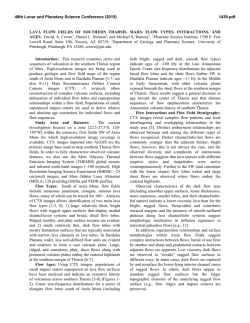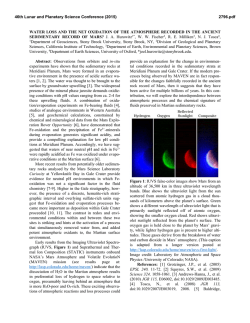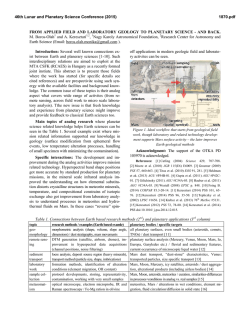
Multi-Rover Framework to Autonomously Explore Planetary Lava
46th Lunar and Planetary Science Conference (2015)
3011.pdf
MULTI-ROVER FRAMEWORK TO AUTONOMOUSLY EXPLORE PLANETARY LAVA TUBES
W. Fink1,2, V. R. Baker3,4, D. Schulze-Makuch5,6, C. W. Hamilton4, and M. A. Tarbell1,2, 1Visual & Autonomous
Exploration Systems Research Laboratory (http://autonomy.arizona.edu), Dept. of Electrical & Computer Engineering, 2Dept. of Aerospace & Mechanical Engineering, 3Dept. of Hydrology & Water Resources, 4Lunar & Planetary
Laboratory, University of Arizona, Tucson, AZ, USA, 5School of the Environment, Washington State University,
Pullman, WA, USA, 6Center of Astronomy & Astrophysics, Technical University Berlin, Berlin, Germany, {wfink,
baker, mtarbell}@email.arizona.edu, [email protected], [email protected].
Introduction: Orbital photographic and remote
sensing surveys of the Moon and Mars both show extensive evidence of lava tube formation [1] (Fig. 1).
Lava tube caves, including collapsed tubes with skylights, are of enormous importance to geology and
astrobiology, because they (1) allow direct examination of bedrock, potentially including materials brought
up from depths that are otherwise inaccessible from the
surface; (2) provide good protection from solar proton
event radiations; and (3) by analogy to Earth, may provide access to a rich biosphere hidden from the surface
[2], specifically adapted to life in that extreme environment. These factors are especially relevant to Mars
where volcanic minerals might provide a source of
nutrients for chemosynthetic organisms [3, 4].
While previous mission paradigms have prevented
exploration of lava tube caves on Mars, new robotic
exploration technologies and paradigms could make
this possible. If life exists on Mars, then lava tubes are
excellent candidates for investigation [3, 4] because
they provide an environment that affords long-term
protection from ultraviolet radiation, a condition that
also makes them attractive for potential human habitation. This affords an excellent set of opportunities to
consider terrestrial analogues that relate to both astrobiological and human habitability on Mars.
A potential point of failure for current missions
arises from the fact that a single agent (e.g., a rover) is
deployed to conduct the entire mission. As such, a single rover must carry onboard all instruments, sensors,
computers, and communications equipment, thus making it very large and cumbersome. Despite this complexity, such rovers are still required to be remotely
commanded and kept from travel into hazardous environments for fear of damage or overturn, thus incurring
loss of the entire mission. All of these deficiencies
hold back the scope of the science mission for which
the rover was deployed.
Multi-Rover Framework: These restrictions
could be mitigated using an alternative multi-rover
architecture for autonomous robotic space exploration.
This system, termed Tier-Scalable Reconnaissance [5–
7], would combine mobile robotic surface probes coupled with a base rover, in situ operational autonomy,
and multi-tiered science reconnaissance to permit ro-
botic traversal of risky, science-rich environments in a
way that the loss of one or more robotic agents need
not jeopardize the entire mission. In this paradigm, the
base rover would map out the best passage for the deployed mobile robotic probes to take in order to reach
their individually assigned science targets.
The necessary operational autonomy for such multi-agent robotic exploration systems can be enabled
through automatic geological feature extraction, operational area characterization, unbiased anomaly detection, and science target prioritization algorithms. In
particular, to enable the operational autonomy element,
an extensible analysis and classification framework,
such as the Automated Global Feature Analyzer
(AGFA; [8, 9]), can be employed for operational areas.
Through image processing algorithms [9] AGFA extracts features and generates feature vectors for all
identified targets. AGFA subsequently prioritizes targets for in situ follow-up investigation [10] and flags
anomalies based on the feature-space alone as opposed
to scientist bias [9]. Moreover, a Stochastic Optimization Framework [11], previously used for operating
robotic arms with N-Degrees Of Freedom (N-DOF)
[12], can be employed for traverse planning, and, in
conjunction with LIght Detection And Ranging
(LIDAR) data, can also be used for autonomous navigation of the mobile robotic surface explorers, without
base rover control, within high-risk areas, such as inside caves or lava tubes on Mars or the Moon.
Lava Tube Exploration: The entrance into a lava
tube cave might be the most challenging part of a future robotic mission. Should a skylight or natural opening be found from the remote sensing survey, it would
not be clear whether the tube is structurally sound or
whether an apparent skylight into a laterally extensive
lava tube is just the opening into a depression bounded
by solid lava on all sides (i.e., “lava-rise pit”) [13, 14].
Furthermore, collapsed rubble at the base of the skylight could make the entry into a lava tube a challenging endeavor. On the other hand, the tube and its opening may have been stable for millions of years on Mars
(or even longer on the Moon). As such, once a rover
makes it inside the lava tube, it would be largely protected from radiation exposure. This would allow the
use of a wide range of sensing equipment that would
46th Lunar and Planetary Science Conference (2015)
otherwise be difficult to maintain if not isolated from
radiation, temperature variations, and dust. Thus, science mission objectives could be increased significantly, in particular with focus on extant or extinct life.
From the point of view of NASA’s Exobiology
Program, lava tube caves would not only provide a
prime location to search for water, but also for life
(i.e., extremophilic organisms), and to undertake geological studies to understand the history of Mars. Examples of suitable analog environments, where robotic
exploration technologies could be tested on Earth, include: (1) Ice Cave at Bandera Volcano in New Mexico, (2) Cueva de los Verdes, Canary Islands, (3) Ape
Cave, Washington State, and (4) Lavic Lake Volcanic
Field in California. In the longer term, lava tube caves
on the Moon and Mars may facilitate the construction
of human settlements in near-surface cavities that provide natural radiation shielding and thermal regulation.
Discussion: The devised multi-rover framework,
i.e., base rover + mini-rovers, and associated navigation algorithms, based on stochastic optimization [11]
and the use of LIDAR, enable the mobile robotic surface probes to operate autonomously, without base
rover control, within high-risk areas (e.g., inside caves
or lava tubes on Mars or the Moon). The stochastic
optimization-based guidance navigation and control
system in conjunction with LIDAR has the potential to
significantly enhance NASA opportunities to create
revolutionary future capabilities to integrate autonomous sensor data interpretation algorithms (e.g., [9,
10]) with a guidance navigation and control system to
create a truly autonomous system for surface exploration of Mars and the Moon. The coordination and implementation of multiple rovers into a tier-scalable
reconnaissance system, with related autonomy of operation, employing enhanced sensory/cognitive capabilities, is the enabling element. Whatever the robotic system that is ultimately deployed on remote planetary
surfaces, isolated from direct Earth command and control, it will have to contend with exactly the same issues of autonomous operation that terrestrial lava tubes
and skylights present. A much more extensive and
detailed discussion of the multi-rover framework presented here is provided in [15].
References: [1] Daga A. et al. (2012) Planet Sci
Decad Surv, 2013–2022. [2] Boston P. J. et al. (2001)
Astrobiol, 1(1), 25. [3] Boston P. J. (2004) Space
Technol Appl Int Forum, 699, 1007–1018. [4] Léveillé
R. J. et al. (2009) PSS, doi:10.1016/j.pss.2009.06.004.
[5] Fink W. et al. (2005) PSS, 53, 1419–1426. [6] Fink
W. et al. (2008) Nova Science, ISBN: 1-60021-826-1.
[7] Kean S. (2010) Science, 329, 508–509. [8] Fink W.
et al. (2005) Geochimica et Cosmochimica Acta,
69(10S), A535. [9] Fink W. et al. (2008) Proc IEEE,
3011.pdf
doi:10.1109/aero.2008.4526422. [10] Fink W. (2006)
Proc IEEE WCCI, 11,116–11,119. [11] Fink W.
(2008) Proc SPIE, doi:10.1117/12.784440. [12] Fink
W. et al. (2010) J Field Robotics, 27(3), 268–280. [13]
Walker G. P. L. (1991) Bull Volcanol, 53, 546–558.
[14] Walker G. P. L. (2009) The Geol Soc Special Publications of IAVCEI, 2, 17–32. [15] Fink W. et al.
(2015) Proc IEEE Aerospace, paper #2723.
Fig. 1. Top: N!huku (a.k.a. Thurston) lava tube on
K"lauea, Hawaii. Middle: Pit (interpreted to be skylight
into a lava tube) on the Moon, located within the Marius Hills (LROC image M122584310L). Bottom: Possible lava tube located on Mars near Hadriaca Patera
(THEMIS image V09784003, rotated by 90° clockwise, added scale bar is approximate).
© Copyright 2024
